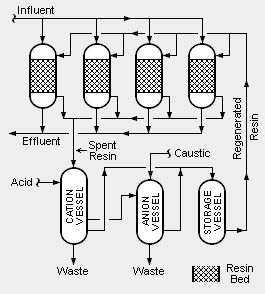User:Milton Beychok/Sandbox: Difference between revisions
Jump to navigation
Jump to search
imported>Milton Beychok No edit summary |
imported>Milton Beychok No edit summary |
||
| Line 1: | Line 1: | ||
'''Condensate polishing''' is a process used to purify the ''steam condensate'' produced in high-pressure [[steam]] generation facilities<ref name=Drbal>{{cite book|author=Larry Drbal, Kayla Westra and Pat Boston|title=Power Plant Engineering|edition=1st Edition |publisher=Springer|year=1996|id=ISBN 0-412-06401-4}}</ref><ref name=Buecker>{{cite book|author=Brad Buecker|title=Fundamentals of Steam Generation Chemistry|edition=1st Edition|publisher=Penwell|year=2000|id=ISBN 0-87814-750-0}}</ref><ref name=EPRIGuidelines> | |||
[http://mydocs.epri.com/docs/public/TR-104422.pdf ''Condensate Polishing Guidelines''] [[Electric Power Research Institute]] (EPRI), 1996</ref><ref name=EPRI>[http://mydocs.epri.com/docs/public/000000000001012208.pdf ''Condensate Polishing State of Knowledge Assessment''] Electric Power Research Institute (EPRI), 2006</ref> such as those in large [[thermal power plants]].<ref>Either nuclear or fuel-fired power plants</ref> Steam condensate is the water formed by condensing the exhaust steam from the [[Steam turbine|steam-driven turbines]] in thermal power plants and which is recycled for reuse as the major part of the steam generation feedwater. | |||
Condensate polishing is a unique application of [[ion-exchange resin]]s that removes suspended and dissolved impurities from the condensate. It is essential for the very stringent quality required of high-pressure steam generation feedwater. | |||
==Types of condensate polishing== | |||
{{Image|Condensate Polisher.png|right|265px|Schematic diagram of a mixed-bed condensate polisher.}} | {{Image|Condensate Polisher.png|right|265px|Schematic diagram of a mixed-bed condensate polisher.}} | ||
==References== | |||
{{reflist}} | |||
Revision as of 02:24, 5 August 2009
Condensate polishing is a process used to purify the steam condensate produced in high-pressure steam generation facilities[1][2][3][4] such as those in large thermal power plants.[5] Steam condensate is the water formed by condensing the exhaust steam from the steam-driven turbines in thermal power plants and which is recycled for reuse as the major part of the steam generation feedwater.
Condensate polishing is a unique application of ion-exchange resins that removes suspended and dissolved impurities from the condensate. It is essential for the very stringent quality required of high-pressure steam generation feedwater.
Types of condensate polishing
References
- ↑ Larry Drbal, Kayla Westra and Pat Boston (1996). Power Plant Engineering, 1st Edition. Springer. ISBN 0-412-06401-4.
- ↑ Brad Buecker (2000). Fundamentals of Steam Generation Chemistry, 1st Edition. Penwell. ISBN 0-87814-750-0.
- ↑ Condensate Polishing Guidelines Electric Power Research Institute (EPRI), 1996
- ↑ Condensate Polishing State of Knowledge Assessment Electric Power Research Institute (EPRI), 2006
- ↑ Either nuclear or fuel-fired power plants
